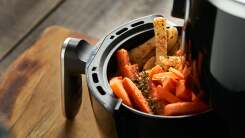What Is a Convection Oven Good for Anyway?
If you, like me, have an oven with a convection setting, there’s a good chance you may not know exactly how it works, what it’s for, or how to actually use it. In conventional ovens, the heat comes from heating units placed at the top and bottom, while a convection oven has a fan and exhaust system that circulates the air. So, what difference does that make?
What are the advantages of a convection oven?
A convection oven has a lot of air flow, which ensures an even temperature through the entire oven. This will result in cutting down on your bake time by about 25 percent, which is more energy efficient, and browning will be more even. A convection oven can be used for most of your baking needs, including roasting meats and vegetables, and cooking casseroles.
If you have an air fryer, you really just have a mini convection oven, in which the hot air circulates through the frying basket, cooking your food quickly and evenly, and giving it that crispy-crunchy texture. If you want a slightly larger convection oven option than an air fryer—but don’t want to replace your entire oven—there are now also toaster ovens with convection settings that can fit on your countertop.

When is using a convection oven not a good idea?
Although a convection oven has a lot of uses, it is not so good with baking delicate dishes, such as cakes, quick breads, biscuits, or cookies, as it can encourage crusts to form too quickly, resulting in flatter baked goods. (The blowing air can also cause the batter to splatter and bake unevenly, though this is rare.) There’s also the fact that most recipes are written with a conventional oven in mind, which means you will need to adjust accordingly if you are planning to use a convection oven instead.
How do you adapt a recipe for a convection oven?
A convection oven is going to heat your dish up faster than a regular oven. In order to adapt a recipe, you’ll either want to reduce the temperature or the baking time. If you decide to adjust the temperature, reduce it by 25° and bake for the same amount of time recommended in the recipe. If you’d rather adjust the cook time, set the temperature at the specified amount, then check for doneness at the ¾ mark.
Updated at 12:35 pm ET on 9/22/21 to include more information about convection ovens and baking.
RECOMMENDED NEWS

Coat Your Cheeseballs in Fried Garlic
2025-10-18

Never Cook These Things in Your Air Fryer
2025-10-14

A 'Dips & Drinks' Theme Will Give Your Super Bowl Party a Competitive Edge
2025-10-15

Your Next Batch of Pancakes Deserves This Ultimate Maple Butter
2025-10-15

Making a Salad Without Lettuce Is Courageous and Smart
2025-10-18

The Best Pumpkin Spice Item Is the Scone, You Fools
2025-10-18
Comments on "What Is a Convection Oven Good for Anyway?" :